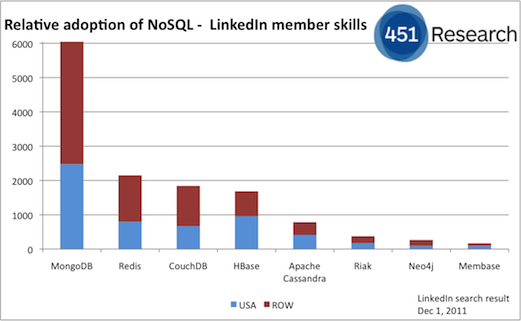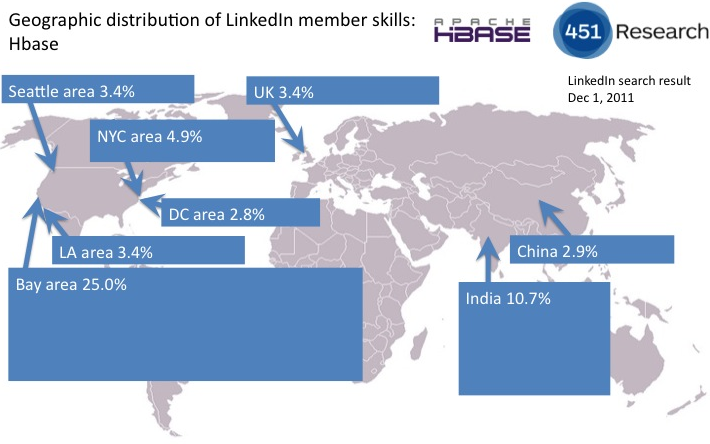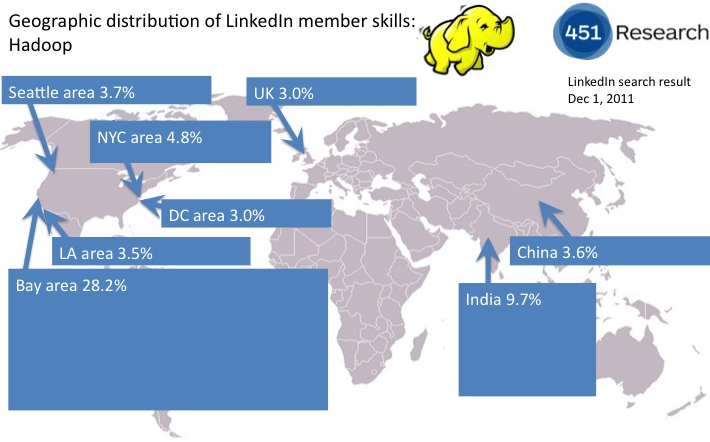March 27th, 2012 — Data management
Back in December we ran a series of posts looking at the geographic distribution of NoSQL skills, according to the results of searching LinkedIn member profiles, culminating in a look at the relative overall popularity of the major NoSQL databases.
This week I took another look at LinkedIn to update the results for a forthcoming report, which gives us the opportunity to see how the results have changed over the past quarter:

While this provides us with an interesting opportunity to track LinkedIn profile mentions over time there isn’t a huge amount we can learn from this first update – other than that MongoDB seems to be increasing its dominance.
The only significant change that isn’t immediately obvious from looking at the chart is that Apache HBase has overtaken Apache CouchDB by a tiny margin to claim third place overall.
As we noted last time, however, Apache HBase is more reliant on the US than other NosQL databases for its LinkedIn mentions: it is the second most prevalent NoSQL database mentioned in the USA but fourth in the rest of the world.
Two other points to take into consideration:
– The results for Apache Cassandra are probably disproportionately low since we have to search for the full phrase in order to avoid including people called Cassandra.
– Previously we only searched for Membase. This time we added together the search results for both Membase and Couchbase. This may mean the result for Couch/Membase is disproportionately high since some members probably listed both.
This is not meant to be a comprehensive analysis, however, but rather a snapshot of one particular data source.
December 12th, 2011 — Data management
Hidden away amongst the details of our little tour around LinkedIn statistics on NoSQL and Hadoop skills was some interesting information on how many LinkedIn members list the various data management technologies in our sample in their profiles.
Our original post contained the fact that there were 9,079 LinkedIn members with “Hadoop” in their member profiles, for example, compared to 366,084 with “MySQL” in their member profiles.
Later posts showed there were 170 with “Membase” and 1,687 with “HBase”, 787 with “Apache Cassandra” and 376 with “Riak”, 6,048 with “MongoDB” and 2,152 with “Redis”, and finally, 1,844 with “CouchDB” and 268 with “Neo4j”.
This gives us an interesting perspective on the relative adoption of the various NoSQL databases:

If it wasn’t already obvious from the list above, the chart illustrates just how much more prevalent MongoDB skills are compared to the other NoSQL databases, followed by Redis, Apache CouchDB, Apache HBase and Apache Cassandra. The chart also illustrates that while HBase is the second most prevalent NoSQL skill set in the USA, it is only fourth overall given its lower prevalence in the rest of the world.
In response, a representative from a certain vendor notes “Some skills are more valued not because they are more prevalent, but because they are harder to achieve.” Make of that what you will.
December 6th, 2011 — Data management
Following last week’s post putting the geographic distribution of Hadoop skills, based on a search of LinkedIn members, in context, this week we will be publishing a series of posts looking in detail at the various NoSQL projects.
The posts examine the geographic spread of LinkedIn members citing a specific NoSQL database in their member profiles, as of December 1, and provides an interesting illustration of the state of adoption for each.
Following yesterday’s look at Membase and HBase, part two examines the geographic spread of Apache Cassandra and Basho Technologies’ Riak.
The statistics showed that 52.2% of the 787 LinkedIn members with “Apache Cassandra” in their member profiles are based in the US (as previously explained, we had to use the ‘Apache’ qualifier with Cassandra to filer out people with the name Cassandra).
A significant proportion (18.0%) of those are in the Bay area, although fewer than Hadoop, Membase and HBase. The results also indicate that Canada is a hot-spot for Apache Cassandra skills, with 4.1%, while Apache Cassandra is also making in-roads into Europe via France and Spain.

Basho’s Riak is less dependent on the USA for adoption. The statistics showed that less than half – 45.5% – of the 376 LinkedIn members with “Riak” in their member profiles are based in the US, with only 13.0% in the Bay area.
Riak hot-spots include the UK (6.9%) and Australia (4.3%). as well as the Boston area, in keeping with the company’s HQ.

The series will continue later this week with MongoDB, CouchDB, Neo4j, and Redis.
N.B. The size of the boxes is in proportion to the search result (click each image for a larger version). World map image: Owen Blacker
December 5th, 2011 — Data management
Following last week’s post putting the geographic distribution of Hadoop skills, based on a search of LinkedIn members, in context, this week we will be publishing a series of posts looking in detail at the various NoSQL projects.
The posts examine the geographic spread of LinkedIn members citing a specific NoSQL database in their member profiles, as of December 1, and provides an interesting illustration of the state of adoption for each.
We begin this week’s series with Membase and HBase, the two projects that proved, like Apache Hadoop, to have significantly greater adoption in the USA compared to the rest of the world.
The statistics showed that 58.2% of the 170 LinkedIn members with “Membase” in their member profiles are based in the US (as previously explained, we tried the same search with Couchbase, but with only 85 results we decided to use the Membase result set as it was more statistically relevant).
As with Hadoop, a significant proportion (27.1%) of those are in the Bay area, the highest proportion of all the NoSQL databases we looked at. The results also indicate that Ukraine is a hot-spot for Membase skills, with 3.5%, while Membase adoption is lower the UK (2.4%) than other NoSQL databases.

It should not be a great surprise that Apache HBase returned similar results to Apache Hadoop. The top eight individual regions for HBase were exactly the same as for Hadoop, although the UK (3.4%) is stronger for HBase, as is India (10.7%).
The statistics showed that 57.0% of the 1,687 LinkedIn members with “HBase” in their member profiles are based in the US, with 25.0% in the Bay area (the third highest in our sample behind Hadoop and Membase).

The series will continue later this week with MongoDB, Riak, CouchDB, Apache Cassandra, Neo4j, and Redis.
N.B. The size of the boxes is in proportion to the search result (click each image for a larger version). World map image: Owen Blacker
December 2nd, 2011 — Data management
NC State University’s Institute for Advanced Analytics recently published some interesting statistics on Apache Hadoop adoption based on a search of LinkedIn data.
The statistics graphically illustrate what a lot of people wer already pretty sure of: that the geographic distribution of Hadoop skills (and presumably therefore adoption) is heavily weighted in favour of the USA, and in particular the San Francisco Bay Area.
The statistics showed that 64% of the 9,079 LinkedIn members with “Hadoop” in their member profiles (by no means perfect but an insightful measure nonetheless) are based in the US, and that the vast majority of those are in the Bay Area.
The results are what we would expect to see given the relative level of immaturity of Apache Hadoop adoption, as well as the nature and location of the early Hadoop adopters and Hadoop-related vendors.
The results got me thinking two things:
– how does the geographic spread compare to a more maturely adopted project?
– how does it compare to the various NoSQL projects?
So I did some searching of LinkedIn to find out.
To answer the first question I performed the same search for MySQL, as an example of a mature, widely-adopted open source project.
The results show that just 32% of the 366,084 LinkedIn members with “MySQL” in their member profiles are based in the US (precisely half that of Hadoop) while only 4.4% are in the Bay area, compared to 28.2% of the 9,079 LinkedIn members with “Hadoop” in their member profiles.
The charts below illustrate the difference in geographic distribution between Hadoop and MySQL. The size of the boxes is in proportion to the search result (click each image for a larger version).


With regards to the second question, I also ran searches for MongoDB, Riak, CouchDB, Apache Cassandra*, Membase*, Neo4j, Hbase, and Redis.
I’ll be posting the results for each of those over the next week or so, but in the meantime, the graphic below shows the split between the USA and Rest of the World (ROW) for all ten projects.
It illustrates, as I suspected, that the distribution of skills for NoSQL databases is more geographically disperse than for Hadoop.
I have some theories as to why that is – but I’d love to hear anyone else’s take on the results.

*I had to use the ‘Apache’ qualifier with Cassandra to filer out anyone called Cassandra, while Membase returned a more statistically relevant result than Couchbase.
World map image: Owen Blacker
April 20th, 2011 — Data management
As we noted last week, necessity is one of the six key factors that are driving the adoption of alternative data management technologies identified in our latest long format report, NoSQL, NewSQL and Beyond.
Necessity is particularly relevant when looking at the history of the NoSQL databases. While it is easy for the incumbent database vendor to dismiss the various NoSQL projects as development playthings, it is clear that the vast majority of NoSQL projects were developed by companies and individuals in response to the fact that the existing database products and vendors were not suitable to meet their requirements with regards to the other five factors: scalability, performance, relaxed consistency, agility and intricacy.
The genesis of much – although by no means all – of the momentum behind the NoSQL database movement can be attributed to two research papers: Google’s BigTable: A Distributed Storage System for Structured Data, presented at the Seventh Symposium on Operating System Design and Implementation, in November 2006, and Amazon’s Dynamo: Amazon’s Highly Available Key-Value Store, presented at the 21st ACM Symposium on Operating Systems Principles, in October 2007.
The importance of these two projects is highlighted by The NoSQL Family Tree, a graphic representation of the relationships between (most of) the various major NoSQL projects:

Not only were the existing database products and vendors were not suitable to meet their requirements, but Google and Amazon, as well as the likes of Facebook, LinkedIn, PowerSet and Zvents, could not rely on the incumbent vendors to develop anything suitable, given the vendors’ desire to protect their existing technologies and installed bases.
Werner Vogels, Amazon’s CTO, has explained that as far as Amazon was concerned, the database layer required to support the company’s various Web services was too critical to be trusted to anyone else – Amazon had to develop Dynamo itself.
Vogels also pointed out, however, that this situation is suboptimal. The fact that Facebook, LinkedIn, Google and Amazon have had to develop and support their own database infrastructure is not a healthy sign. In a perfect world, they would all have better things to do than focus on developing and managing database platforms.
That explains why the companies have also all chosen to share their projects. Google and Amazon did so through the publication of research papers, which enabled the likes of Powerset, Facebook, Zvents and Linkedin to create their own implementations.
These implementations were then shared through the publication of source code, which has enabled the likes of Yahoo, Digg and Twitter to collaborate with each other and additional companies on their ongoing development.
Additionally, the NoSQL movement also boasts a significant number of developer-led projects initiated by individuals – in the tradition of open source – to scratch their own technology itches.
Examples include Apache CouchDB, originally created by the now-CTO of Couchbase, Damien Katz, to be an unstructured object store to support an RSS feed aggregator; and Redis, which was created by Salvatore Sanfilippo to support his real-time website analytics service.
We would also note that even some of the major vendor-led projects, such as Couchbase and 10gen, have been heavily influenced by non-vendor experience. 10gen was founded by former Doubleclick executives to create the software they felt was needed at the digital advertising firm, while online gaming firm Zynga was heavily involved in the development of the original Membase Server memcached-based key-value store (now Elastic Couchbase).
In this context it is interesting to note, therefore, that while the majority of NoSQL databases are open source, the NewSQL providers have largely chosen to avoid open source licensing, with VoltDB being the notable exception.
These NewSQL technologies are no less a child of necessity than NoSQL, although it is a vendor’s necessity to fill a gap in the market, rather than a user’s necessity to fill a gap in its own infrastructure. It will be intriguing to see whether the various other NewSQL vendors will turn to open source licensing in order to grow adoption and benefit from collaborative development.
NoSQL, NewSQL and Beyond is available now from both the Information Management and Open Source practices (non-clients can apply for trial access). I will also be presenting the findings at the forthcoming Open Source Business Conference.











 Subscribe via RSS
Subscribe via RSS